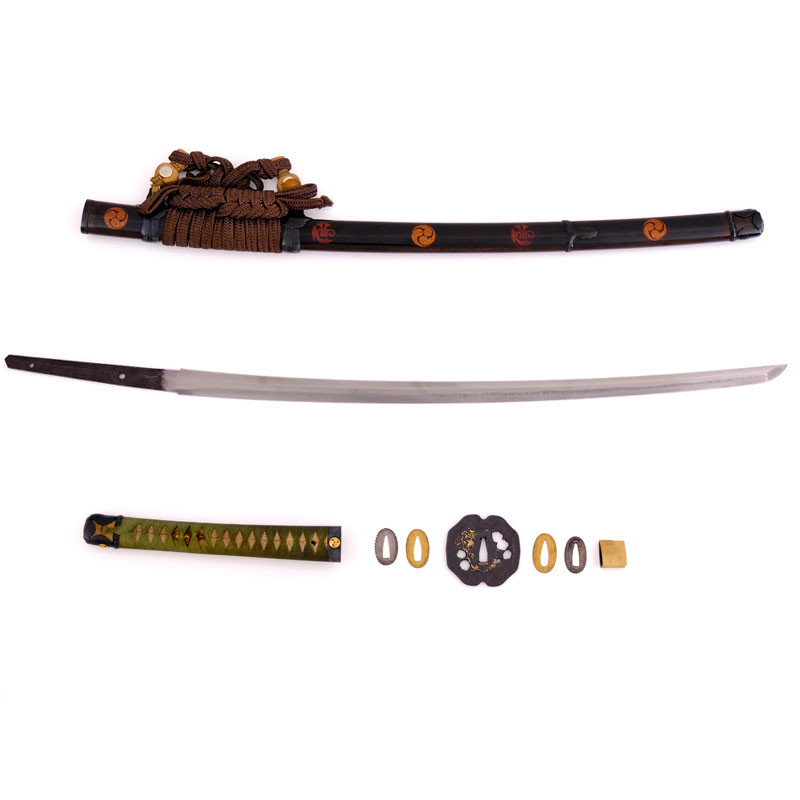










































































More informations about this product
| Total Weight | 1.560 kg | |
| Weight without Saya | 1.079 kg | |
| Blade Weight | 0.671 kg | |
| Full Blade length (Toshin) | 89.40 cm | |
| Nagasa | 69.45 cm | |
| Nakago Length | 20.10 cm | |
| Sori (curvature) | 1.69 cm | |
| Kissaki Length | 2.79 cm | |
| Moto Haba | 2.98 cm | |
| Saki Haba | 1.92 cm | |
| Moto Kasane | A = 0.69 cm B = 0.69 cm |
|
| Saki Kasane | A = 0.49 cm B = 0.55 cm |
|
| Curvature | Tori Zori (half blade) | |
| Type Kissaki | Chu Kissaki | |
| Blade Structure | Shinogi Zukuri (diamond shaped) | |
| Mune | Iori Mune (triangular) | |
| Hamon | Straight line start Yakidashi typical of Osaka, then Gunome Choji Midare large in very active Nie with peaks. (similar to the Fukuoka Ichimonji school of the Kamakura period). |
|
| Hada | Ko Itame | |
| Boshi | Ko Maru Sagari with a short Kaeri | |
| Nakago | Length of 20.10cm, Ubu signed Ura Tachi side, Yasurime oblique very inclined O Sujikai, 2 Mekugi Ana, Futsu Gata shape, end in Kata Yamagata (dissymmetric V). | |
| Saya | Length 78.8 cm, weight 480g, Tachi assembly with Sayajiri, Semegane, Ashi and Koiguchi in sequence in Shakudo. Brown silk sageo, shiny black shimmer glitter brown with patterns of Mon ‘Mitsu Tomoe’ 三 ツ 巴 and ‘Gion Mamori” 祇 園 守. Symbols:
|
|
| Tsuka & Tosogu (Tsuba, Menuki, Fuchi Kashira) |
- Tsuka: 176g, 28.5cm, Tsumami Maki silk braiding in olive green color, high quality whole Same White, - Menuki : Soten on the grounds of a sage with a golden fan Tsuba : 170g, Width 8.22cm x height 7.97cm x thickness 0.55cm, Signed Yasaka Shigenaga 八坂重永, with NBTHK certificate, Hachi Gaku Gata octagonal shape, with Sukashi openings depicting snowflakes, with inscriptions (5 sigillary symbols, ancient Japanese script). Yasaka Shigenaga was a tsuba maker from Bungo, where a river called Yasaka flows. Fuchi and Kabuto gane: in Shakudo with embossed patterns of ‘Mitsu Tomoe” 三ツ巴 and ‘Gion Mamori’ 祇園守. Fuchi signed ‘Shigeaki (Kao)’ 重明 (花押). - Habaki: 32g, Double habaki in golden copper, horizontal Nekogaki on the lower part and vertical on the upper part. Seppa: 28g (4 Seppa), 2 Seppa in silver-plated copper, 2 Seppa in copper covered with a golden leaf. |
|
| Study & Team Review |
Yasuhiro 康廣 is, with his brother Tameyasu 為康 2nd generation, the founder of the Osaka Ishido school. |
|
Share your opinion
error Your review appreciation cannot be sent
feedback Report comment
check_circle Report sent
error Your report cannot be sent